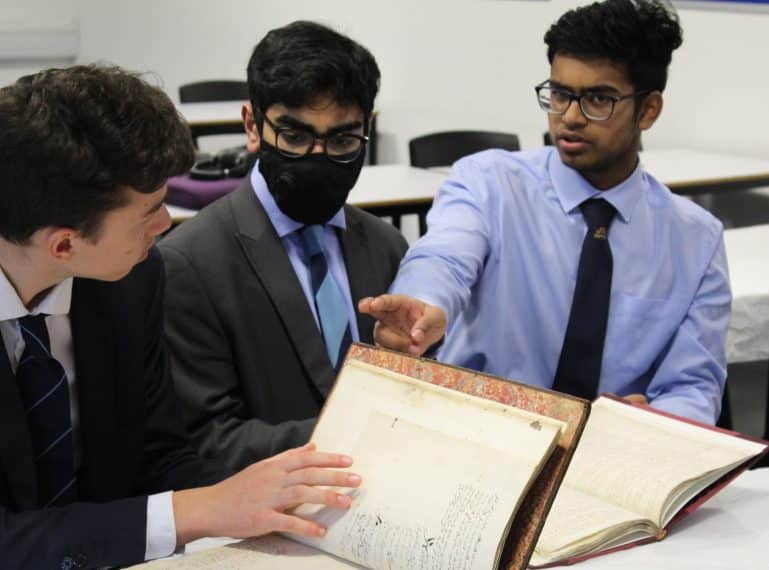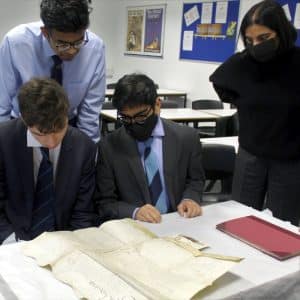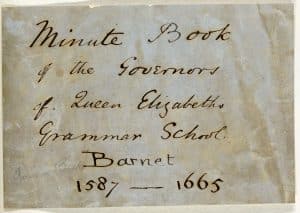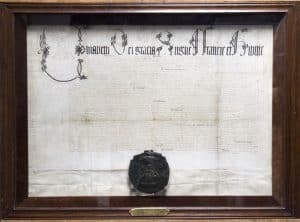A first for QE? Sixth-formers delve deep into the School’s history through new Palaeography Society

A new School society – believed to be the first of its kind in the country – is working hard to decipher QE’s earliest written records.
 English teacher Kanak Shah has brought together a group of dedicated Year 12 boys and trained them in palaeography – the study of ancient and pre-modern manuscripts.
English teacher Kanak Shah has brought together a group of dedicated Year 12 boys and trained them in palaeography – the study of ancient and pre-modern manuscripts.
Now they have started transcribing QE Governors’ meeting minutes, starting with Volume I, which begins in 1587, and also researching the School Charter, which dates back to the School’s founding year, 1573.
Ms Shah, who has an MPhil degree in Renaissance Literature from Cambridge, said: “Due to its complexity, palaeography is usually only studied at Master’s level. But since I myself have a keen interest in palaeography, manuscripts and the early modern period, and since QE boasts one of the most robust school archive collections in the UK, I was eager for the students to be involved in preserving and curating their own School’s history.”
Working together with Ms Shah and Jenni Blackford, Curator of QE Collections and Head of Library Services, are the following Year 12 A-level History students: Gabriel Gulliford, Ishaan Mehta, Muhammad Nayel Huda, Kai Mukherjee, Danny Adey, Conall Walker and Jeeve Singh. All are currently studying the early modern period and are considering pursuing courses in subjects such as History, Palaeography or Archaeology at university.
“We started by following Cambridge University’s English Handwriting 1500-1700 online course to develop the students’ transcription skills. We then began to transcribe the digitised manuscripts on QE Collections [the School’s publicly available digital archive, launched last year].
 “The earliest documents present an interesting challenge as they were written before the standardisation of handwriting, and so require careful decoding,” said Ms Shah.
“The earliest documents present an interesting challenge as they were written before the standardisation of handwriting, and so require careful decoding,” said Ms Shah.
Having initially familiarised themselves with the subject matter digitally, the group are now working with the original archive materials, guided by Mrs Blackford.
They plan to publish the transcripts on QE Collections in the Summer Term, while they will contribute their research to an exhibition of archival material planned for the School’s 450th anniversary next year.
“Looking forward to the future, we would be keen to establish a working relationship with Barnet Museum, who possess a complete transcription of these Governor’s minutes that was done many years ago,” said Ms Shah.
 It is not clear who made the the Barnet Museum transcription, which was completed some time prior to 1931. The preface to the museum’s collection of QE translations and transcriptions was written in May 1931 by Cecil L Tripp, author of A History of Queen Elizabeth’s Grammar School, published 1935.
It is not clear who made the the Barnet Museum transcription, which was completed some time prior to 1931. The preface to the museum’s collection of QE translations and transcriptions was written in May 1931 by Cecil L Tripp, author of A History of Queen Elizabeth’s Grammar School, published 1935.
“Transcriptions are often erroneous and subjective, so it is very interesting for the boys to compare their own work with the museum’s transcription, and to contribute to Barnet’s history in such an active way.”
Once the pupils’ transcription has been completed and it and the Barnet Museum transcription have been digitised, they will both be published on QE Collections.
